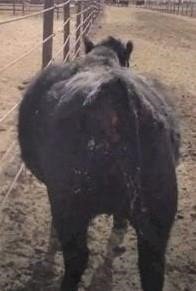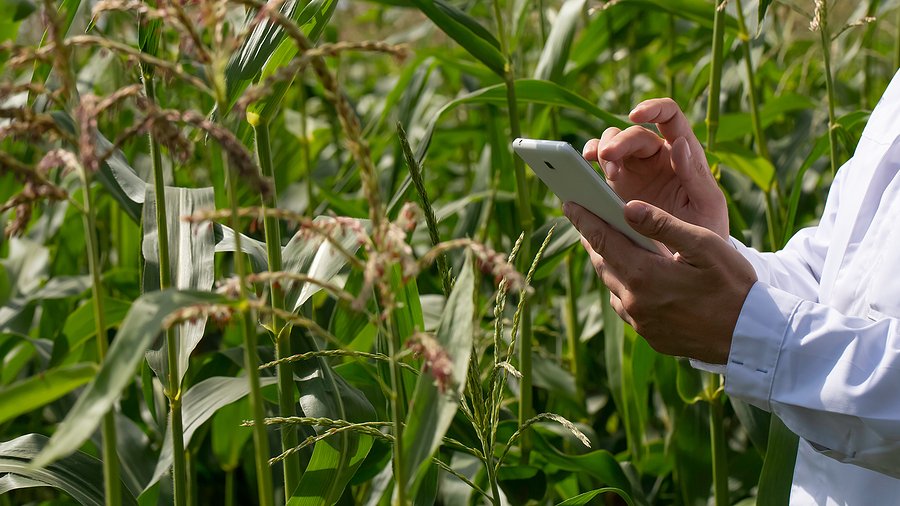By Jerad Jaborek
Bloat is a digestive dysfunction that outcomes from the buildup of extreme gasoline inside the rumen and might result in dying of the animal by asphyxiation. Gases comparable to carbon dioxide and methane are regular by-products produced throughout microbial fermentation of feed stuffs. The gases produced within the rumen can both be absorbed by the rumen wall, journey by reticulum and the remaining digestive tract, or predominately, they are eructated or belched out by the esophagus. Eructation of gasoline from the rumen by the esophagus is finished by a collection of muscular contractions that’s initiated by the buildup of gasoline inside the rumen to sign for its launch. Nevertheless, correct rumen perform and motility will be impaired by giant quantities of acids produced throughout ruminal fermentation. If regular rumen contractions are prevented or if the esophagus is obstructed, bloat can happen.

An instance of an animal with a extreme case of bloat from a Veterinary Clinics: Meals Animal Observe article by Meyer and Bryant.
In response to an article from the Journal of Animal Science by Cheng and others, there are two sorts of bloat: free-gas bloat or frothy bloat. Free-gas bloat can happen when the esophagus turns into obstructed by incompletely processed or chewed feeds (e.g., potatoes, beets, apples, turnips) and even hay twine. Free-gas bloat can additionally be attributable to a scarcity of rumen motility, which will be attributable to injury to the vagus nerve by pneumonia, {hardware} illness, or thoracic abscesses. Moreover, rumen motility will be impaired by the onset of acidosis, and hypocalcemia. Frothy bloat develops when a secure foam varieties within the rumen and traps gases within the rumen liquid section, stopping the separation of rumen feed particles and liquids from the gasoline inside the rumen. Because the rumen fills from elevated digesta and gasoline accumulation, frothy foam formation can impede the esophagus from permitting gases to be belched from the rumen, thus inflicting the animal to bloat.
Indicators of bloat
Through the onset of bloat, the left paralumbar fossa (triangular space between the final rib and hook bone) turns into distended. Because the severity of bloat progresses, the distention of the paralumbar fossa will turn out to be extra apparent, the rectum might start to protrude from the animal, and strain on the diaphragm might trigger the animal to have problem respiratory and be unwilling to maneuver in accordance with a Veterinary Clinics: Meals Animal Observe article by Meyer and Bryant.
Remedy of bloat
In response to an Alberta Agriculture and Rural Growth publication by Majak and others, a giant diameter hose or tube (0.75 inch diameter, or a normal backyard hose) will be positioned within the animal’s mouth, permitting them to swallow it so it passes by the esophagus and into the rumen. Watch out to not place the hose or tube within the lungs. Ensure the hose or tube is cleared and transfer it forwards and backwards to achieve totally different areas of the rumen. If gasoline doesn’t seem like escaping the rumen from the hose or tube, take away the hose or tube and verify the tip for froth. For therapy of frothy bloat, non-toxic oils, comparable to a mineral or vegetable oils, will be administered at a fee of 1.0 to 1.2 oz./100 lb. of physique weight into the rumen through a abdomen tube or drench. In extreme circumstances of bloat, surgical intervention could also be wanted. Contact your veterinarian, as a rumenotomy might must be carried out or a trocar and cannula might must be inserted into the paralumbar fossa to relieve gasoline from the rumen.
Bloat Prevention
Acidosis and bloat will be interrelated, with acidosis predisposing animals to bloat. Utilizing administration practices that contemplate the correct quantity of grain and roughage within the weight-reduction plan, correct grain choice and processing, use of correct bunk administration, use of feed components, and permitting ample time between weight-reduction plan transitions may help to restrict the incidence of acidotic bouts in feedlot cattle. Moreover, correct forage species choice and grazing administration practices will assist to stop pasture bloat in grazing cattle.
The fermentation of grains within the rumen results in the manufacturing of risky fatty acids (VFA) for vitality use in ruminants. Larger VFA manufacturing and absorption sometimes ends in the best physique weight features. Nevertheless, if VFA manufacturing is simply too fast, rumen pH and rumen motility can lower, main to acidosis and bloat. Take into account managing the quantity of feed supplied and doable programmed consumption methods to stop binge consuming occasions by animals. Starch fermentation from grains is extra fast for smaller grains (oats, barely, rye) and from finely processed grains. Ensure to offer sufficient roughage or fiber within the weight-reduction plan. Most ending rations fed to feedlot cattle include 10 to fifteen% roughage. Additionally enable ample time for cattle to adapt to consuming high-grain diets. Improve the quantity of grain inside the weight-reduction plan slowly over the course of a pair weeks and chorus from making giant modifications within the quantity of feed supplied. Moreover, the inclusion of ionophores, comparable to Rumensin and Bovatec, within the weight-reduction plan have been proven to lower the incidence of bloat.
Grazing alfalfa, crimson clover, white clover, candy clover, and winter wheat have a larger probability of inflicting frothy bloat. Moreover, bloat is extra frequent when these beforehand talked about forages are consumed at earlier development levels. Due to this fact, contemplate acceptable forages for pasture mixes and grazing administration practices to keep away from pasture bloat.
In abstract, there are two sorts of bloat, free-gas bloat and frothy bloat, that trigger the construct of gasoline inside the rumen and might in the end result in dying by asphyxiation. Generally refined or unnoticeable modifications in cattle feed consumption, feed administration, grain processing, pasture development, and climate modifications could cause bloat to happen. Keep in mind to maintain a cautious look ahead to indicators of bloated animals and be ready to deal with bloated animals shortly when bloat happens.
Supply : osu.edu














